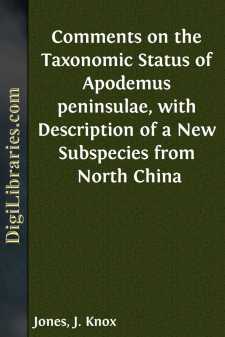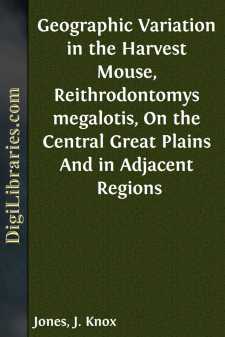Categories
- Antiques & Collectibles 13
- Architecture 36
- Art 48
- Bibles 22
- Biography & Autobiography 813
- Body, Mind & Spirit 142
- Business & Economics 28
- Children's Books 14
- Children's Fiction 11
- Computers 4
- Cooking 94
- Crafts & Hobbies 4
- Drama 346
- Education 46
- Family & Relationships 57
- Fiction 11829
- Games 19
- Gardening 17
- Health & Fitness 34
- History 1377
- House & Home 1
- Humor 147
- Juvenile Fiction 1873
- Juvenile Nonfiction 202
- Language Arts & Disciplines 88
- Law 16
- Literary Collections 686
- Literary Criticism 179
- Mathematics 13
- Medical 41
- Music 40
- Nature 179
- Non-Classifiable 1768
- Performing Arts 7
- Periodicals 1453
- Philosophy 64
- Photography 2
- Poetry 896
- Political Science 203
- Psychology 42
- Reference 154
- Religion 513
- Science 126
- Self-Help 84
- Social Science 81
- Sports & Recreation 34
- Study Aids 3
- Technology & Engineering 59
- Transportation 23
- Travel 463
- True Crime 29
Comments on the Taxonomic Status of Apodemus peninsulae, with Description of a New Subspecies from North China
by: J. Knox Jones
Description:
Excerpt
In the past several years the United States National Museum has received a large number of mammals from central and southern Korea through the auspices of the Commission on Hemorrhagic Fever of the Armed Forces Epidemiological Board. Among these Korean collections are more than a hundred specimens of a murine rodent originally described as "Micromys speciosus peninsulae" by Oldfield Thomas but currently placed in the genus Apodemus. In attempting to ascertain the specific relationships of this mouse I have examined, through the generosity of Dr. David H. Johnson, Acting Curator of Mammals, most of the other Oriental specimens of the subgenus Sylvaemus in the U. S. National Museum and it is on this combined material that the following comments and description are based.
Three general groups of the genus Apodemus are presently known to occur on the mainland of northeast Asia. One is the distinctive Apodemus agrarius, lone representative of the subgenus Apodemus. The others, both in the subgenus Sylvaemus and closely resembling each other, are represented by a small animal that is currently regarded as conspecific with Apodemus sylvaticus and a larger animal of which the Korean mouse, peninsulae, is representative. The oldest trivial name applied to the large Sylvaemus is major of Radde, 1862, in the combination [Mus sylvaticus] vrt. major. This is, however, twice preoccupied (see Ellerman and Morrison-Scott, 1951:566). The next available name is peninsulae of Thomas, 1907, which was applied to mice from central and southern Korea (type from Mun'gyong, 110 mi. SE Seoul, Korea), and was originally proposed as a subspecies of the insular Japanese species, Apodemus speciosus. G. M. Allen (1940:949), who recognized peninsulae as a monotypic species, was the first investigator to make the important distinction that it was not conspecific with the Japanese speciosus, although Hollister (1913:1-2) and Miller (1914:89) had previously used the combination Apodemus peninsulae, evidently with the same thought in mind.
Fig. 1. Ventral views of skulls and left maxillary tooth-rows of two species of the genus Apodemus.a.Apodemus flavicollis flavicollis(Melchior), Lolland, Denmark, adult ââ¢â, No. 141691 USNM, ×2.
b.Apodemus flavicollis flavicollis(Melchior), Mauseklippe, Germany, young ââ¢â, No. 112895 USNM, ×10.
c.Apodemus peninsulae peninsulae(Thomas), Central Nat'l Forest, near Pup'yong-ni, 200 m., Korea, subadult Ãâ2, No. 300650 USNM, ×10.
d.Apodemus peninsulae peninsulae(Thomas), 6 mi. S Yongdongp'o, Korea, adult ââ¢â, No. 299554 USNM, ×2.
In comparing the ventral views of skulls note especially the size and location of incisive foramina and posterior palatine foramina as well as the breadth of mesopterygoid fossae. In comparing the left maxillary tooth-rows note especially the size of M3 and the reduced posterointernal cusp on Ml in A. peninsulae.]
More recently, Ellerman (1949:32) and Ellerman and Morrison-Scott (1951:566) have arranged peninsulae as a subspecies of Apodemus flavicollis under the assumption that all the members of the subgenus Sylvaemus on the eastern Asiatic mainland are subspecies of one or another of the species of western Europe, A. flavicollis or A. sylvaticus. Ellerman (in Ellerman and Morrison-Scott, 1951:564) states: "The majority of the forms I distribute in a somewhat arbitrary manner between sylvaticus, average smaller skull, and flavicollis, average larger skull; occurring together nearly throughout the Palaearctic. I feel fairly sure that there are some errors of judgment in my arrangement, and equally sure that there is no other way to define species in this very large and difficult group." I have compared the specimens of peninsulae available to me from central and southern Korea with specimens of A....










